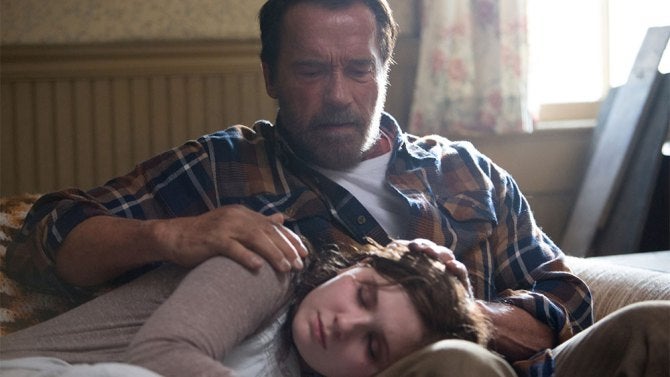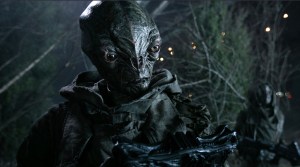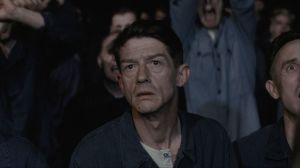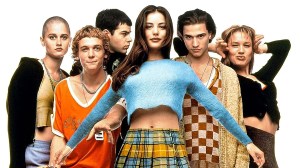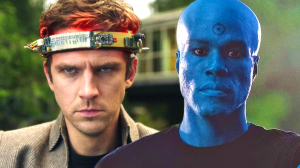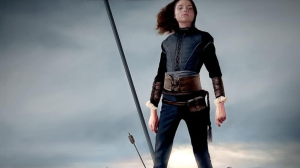Maggie is not your standard zombie film. Rather than focusing on the shock value and gore that have helped to make The Walking Dead so popular, it inverts many of the stock horror tropes in favor of something surprising. It is a small film both in its release and scope (discovered on the “Hollywood Blacklist” of film scripts), but features a pair of big stars in Arnold Schwarzenegger and Abigail Breslin. Together, they form the emotional core of a film that is just as much about loss and acceptance, as it is about the living dead.
Videos by ComicBook.com
Director Henry Hobson tells the story of Wade (Schwarzenegger) and Maggie (Breslin), a father and his teenage daughter living in the aftermath of a zombie outbreak. Maggie has fled her father’s life on the farm for Kansas City, only to be bitten by a zombie upon arriving. As the film begins, Wade is on his way to pick up Maggie as the infection begins. But unlike most zombie interpretations, it can take weeks or months for humans to transform into the undead. Wade struggles to help his daughter through those final weeks, as she attempts to find meaning in life before she “turns”.
Hobson doesn’t discard horror tropes in Maggie, but never emphasizes them either. The film deals with the process of loss, reflecting almost the entire spectrum of the Kubler-Ross Model. This is all grounded in the story of Wade and Maggie. Doctors, friends, and even the rest of Maggie and Wade’s family, primarily serve to reflect what these two are feeling and challenge their decisions. Several other families in town are used to set up the process that Maggie will eventually face, and the possible results. Even Wade’s second wife (Joely Richardson providing a strong, multi-faceted performance in very few scenes) seems to float away with no remark in the end, in order to allow the father and daughter to share the films final act.
Schwarzenegger and Breslin’s performances are the core of the film, and they don’t require any more support than what they receive. They are both experienced actors (it has been almost ten years since Breslin starred in Little Miss Sunshine) and appear to relish the film’s extremly personal scale. Maggie rests well on their backs, despite a lackluster pace and washed out color palette, providing life in what could have been a bleak, heartless story.
It is the strength of Schwarzenegger’s role that comes as Maggie’s biggest surprise. He provides a quiet and shockingly subtle performance. Wade is a quiet man who keeps his own counsel, an American ideal of farmland masculinity. That characterization is consistent, never providing him with an easy opportunity to lash out or explain his feelings. Instead, Schwarzenegger is tasked with carrying Wade’s internal struggles and thought processes through his face and body alone. Silent close ups and extended shots of his reactions reveal all that is necessary in silence.
The moments in which he does break from the quiet of his role are when he is interacting directly with Breslin. They share a strong familial chemistry on screen and are never better than when they are together. Their shared scenes are the moments when Maggie is truly at its best. A sequence at the dinner table in which Schwarzenegger praises his wife’s cooking while making faces when her back is turned, stoking laughter from Breslin feels natural and incredibly endearing.
It’s unfortunate that the two do not interact much until about halfway through the film. The first scenes they share where Maggie is not withdrawn do not occur until the 45 minute mark, leaving the first half of the film without much to draw viewers in or provide them with a reason to care. The thoughtful pacing devolves into a plodding rhythm in this half of the film and at certain moments later on, dragging on through over-long sequences and familiar settings. It feel like there was a much more effective version of John Scott III’s script to be discovered in a 60 or 70 minute cut of the film, but that it was edited to fill a more standard running time.
This would be improved if so much of the film were not shot in a repetitive fashion. Similar music, sequences, and cut aways are repeated during and between scenes. Rather than being reflective, long shots of trees and fields begin to feel like filler in order to bump up the film’s running time. Hobson uses the same style of montage – unfocused mid- and close-range shots covering an undefined period of time – at several points in the film. It feels lazy the first time it appears, and is grating when it resurfaces.
The slower pacing of the film is used to much greater effect when evoking tension and horror in the audience. Maggie is not filled with many significant turning points, but each is made to land intensely. Hobson seeds each of these moments well before they occur, injecting choice bits of dialogue and visual cues. As Maggie’s “turn” draws ever closer, the audience becomes distinctly aware of the inevitability of certain moments. The slow build towards each of these is drawn out, ratcheting up tension and forcing viewers to twist in their seat unable to look away. The same style that renders teenage gatherings and doctor’s visits so stale makes for very effective horror.
The fear and effect come from the inability to avoid these conclusions, not visual effects or make up. There is a conscious choice to focus on the impact of Wade and Maggie’s choices, rather than the horrific rendering of what happens. Rather than showing the landing of an axe or firing of a gun, the camera cuts away at the moment of impact. It’s a release of tension that centers the audience on what the characters are experiencing, making what is not shown every bit as important as what is.
At its heart, Maggie is a story about grief and loss, not zombies. The direct confrontation of the inevitability of death is simply a tool that allows for () to draw forth the tension and terror inherent within a fatal illness. Even when the film drags its feet and shambles through cliches, S Schwarzenegger and Breslin are capable of maintaining a compelling emotional narrative. It is their on screen relationship that drives the movie and gives viewers a reason to keep watching. Together they show that fictional monsters are not nearly as frightening as accepting the loss of those you love most.
Grade: C+

